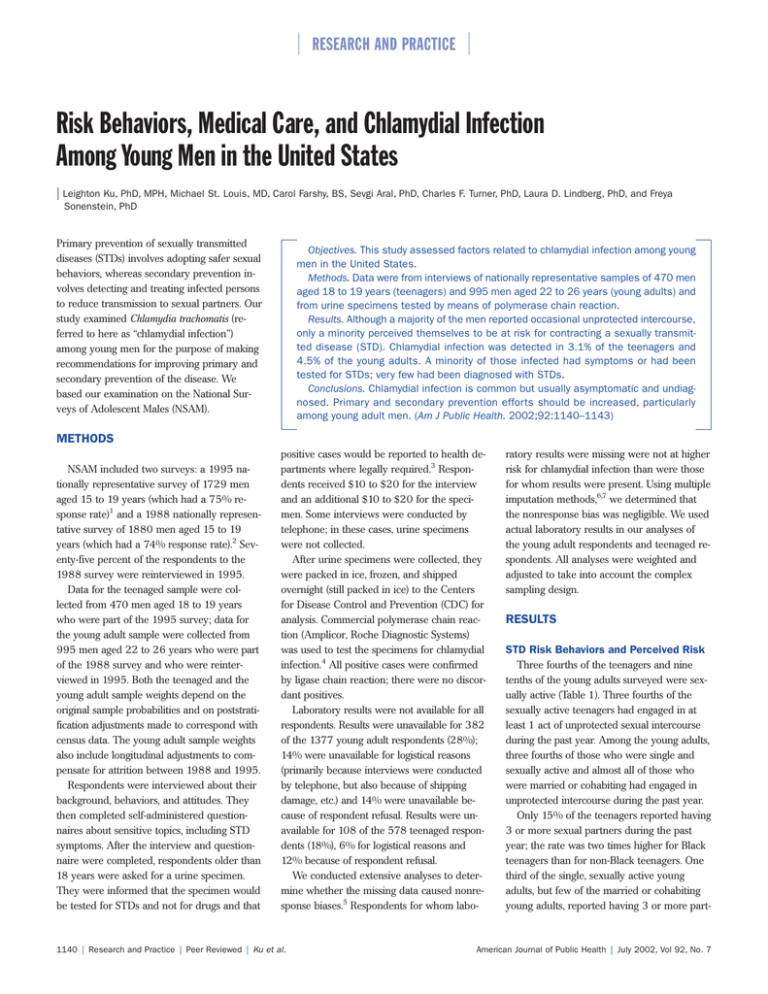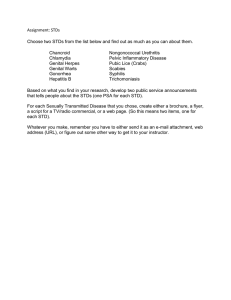
RESEARCH AND PRACTICE
Risk Behaviors, Medical Care, and Chlamydial Infection
Among Young Men in the United States
| Leighton Ku, PhD, MPH, Michael St. Louis, MD, Carol Farshy, BS, Sevgi Aral, PhD, Charles F. Turner, PhD, Laura D. Lindberg, PhD, and Freya
Sonenstein, PhD
Primary prevention of sexually transmitted
diseases (STDs) involves adopting safer sexual
behaviors, whereas secondary prevention involves detecting and treating infected persons
to reduce transmission to sexual partners. Our
study examined Chlamydia trachomatis (referred to here as “chlamydial infection”)
among young men for the purpose of making
recommendations for improving primary and
secondary prevention of the disease. We
based our examination on the National Surveys of Adolescent Males (NSAM).
Objectives. This study assessed factors related to chlamydial infection among young
men in the United States.
Methods. Data were from interviews of nationally representative samples of 470 men
aged 18 to 19 years (teenagers) and 995 men aged 22 to 26 years (young adults) and
from urine specimens tested by means of polymerase chain reaction.
Results. Although a majority of the men reported occasional unprotected intercourse,
only a minority perceived themselves to be at risk for contracting a sexually transmitted disease (STD). Chlamydial infection was detected in 3.1% of the teenagers and
4.5% of the young adults. A minority of those infected had symptoms or had been
tested for STDs; very few had been diagnosed with STDs.
Conclusions. Chlamydial infection is common but usually asymptomatic and undiagnosed. Primary and secondary prevention efforts should be increased, particularly
among young adult men. (Am J Public Health. 2002;92:1140–1143)
METHODS
NSAM included two surveys: a 1995 nationally representative survey of 1729 men
aged 15 to 19 years (which had a 75% response rate)1 and a 1988 nationally representative survey of 1880 men aged 15 to 19
years (which had a 74% response rate).2 Seventy-five percent of the respondents to the
1988 survey were reinterviewed in 1995.
Data for the teenaged sample were collected from 470 men aged 18 to 19 years
who were part of the 1995 survey; data for
the young adult sample were collected from
995 men aged 22 to 26 years who were part
of the 1988 survey and who were reinterviewed in 1995. Both the teenaged and the
young adult sample weights depend on the
original sample probabilities and on poststratification adjustments made to correspond with
census data. The young adult sample weights
also include longitudinal adjustments to compensate for attrition between 1988 and 1995.
Respondents were interviewed about their
background, behaviors, and attitudes. They
then completed self-administered questionnaires about sensitive topics, including STD
symptoms. After the interview and questionnaire were completed, respondents older than
18 years were asked for a urine specimen.
They were informed that the specimen would
be tested for STDs and not for drugs and that
positive cases would be reported to health departments where legally required.3 Respondents received $10 to $20 for the interview
and an additional $10 to $20 for the specimen. Some interviews were conducted by
telephone; in these cases, urine specimens
were not collected.
After urine specimens were collected, they
were packed in ice, frozen, and shipped
overnight (still packed in ice) to the Centers
for Disease Control and Prevention (CDC) for
analysis. Commercial polymerase chain reaction (Amplicor, Roche Diagnostic Systems)
was used to test the specimens for chlamydial
infection.4 All positive cases were confirmed
by ligase chain reaction; there were no discordant positives.
Laboratory results were not available for all
respondents. Results were unavailable for 382
of the 1377 young adult respondents (28%);
14% were unavailable for logistical reasons
(primarily because interviews were conducted
by telephone, but also because of shipping
damage, etc.) and 14% were unavailable because of respondent refusal. Results were unavailable for 108 of the 578 teenaged respondents (18%), 6% for logistical reasons and
12% because of respondent refusal.
We conducted extensive analyses to determine whether the missing data caused nonresponse biases.5 Respondents for whom labo-
1140 | Research and Practice | Peer Reviewed | Ku et al.
ratory results were missing were not at higher
risk for chlamydial infection than were those
for whom results were present. Using multiple
imputation methods,6,7 we determined that
the nonresponse bias was negligible. We used
actual laboratory results in our analyses of
the young adult respondents and teenaged respondents. All analyses were weighted and
adjusted to take into account the complex
sampling design.
RESULTS
STD Risk Behaviors and Perceived Risk
Three fourths of the teenagers and nine
tenths of the young adults surveyed were sexually active (Table 1). Three fourths of the
sexually active teenagers had engaged in at
least 1 act of unprotected sexual intercourse
during the past year. Among the young adults,
three fourths of those who were single and
sexually active and almost all of those who
were married or cohabiting had engaged in
unprotected intercourse during the past year.
Only 15% of the teenagers reported having
3 or more sexual partners during the past
year; the rate was two times higher for Black
teenagers than for non-Black teenagers. One
third of the single, sexually active young
adults, but few of the married or cohabiting
young adults, reported having 3 or more part-
American Journal of Public Health | July 2002, Vol 92, No. 7
RESEARCH AND PRACTICE
TABLE 1—STD Behaviors, Perceptions, Symptoms, Testing, and Diagnosis Among US Teenaged
and Young Adult Men
Men Aged 18–19 Years
All
Unweighted sample sizea
Sexual behaviors
Had sex with female during past year
Had any unprotected sex during past year
Had 3 or more female partners during past year
Had sex with high-risk partner during past year b
STD perceptions
Believes he is at some risk for STDs
Believes last sexual partner is at some risk for STDsc
STD symptoms
Ever had STD symptomsd
Had STD symptoms during past year
Health access
Has health insurance
Had physical exam during past year
STD testing
Had STD test during past year
Had STD test during past year (among those symptomatic)
STD diagnosis
Medical professional said he had an STD during past year
Told he had an STD during past year e
470
Black
139
73.4%
54.9
14.9
85.6%
60.7
27.8
2.9
4.6
40.7
24.7
Men Aged 22–26 Years
Non-Black
Sexually
Active
331
357
71.4%*
54.0
12.8***
All
995
Black
371
Non-Black
624
Married or
Single,
Cohabiting Sexually Active
356
543
100.0%
73.3
20.3
88.6%
77.3
18.0
91.2%
78.5
29.3
88.2%
77.1
16.0***
99.2%
98.2
3.7
100.0%
76.4***
33.6***
2.7
3.9
6.8
13.6
5.6***
6.4
7.3
37.1
27.1
41.3
24.3
42.2
24.7
26.4
16.1
33.6
14.6
25.2*
16.4
12.7
4.8
39.9***
25.2***
20.3
7.4
25.4
14.9
19.5
6.2*
21.9
8.4
20.9
8.2
31.5
11.4
19.1***
7.7
17.0
6.1
22.1
8.5
78.1
67.6
83.2
68.0
77.3
67.6
77.9
67.2
74.1
55.3
74.3
63.5
74.1
53.8**
76.1
56.9
71.8
59.0*
15.8
25.6
36.2
56.4
12.6***
13.8**
19.4
30.1
17.3
33.5
32.0
53.9
14.8***
28.7*
15.6
29.8
21.1**
46.5
2.7
11.4
13.7
35.7
1.0***
0.3***
3.7
12.4
1.6
8.1
5.7
15.9
0.9***
5.4**
0.4
1.8
2.8**
12.1
Note. Significance tests compare levels for Black vs. non-Black men among the 18–19 year olds and for Black vs. non-Black and for married/cohabiting vs. single sexually active men among 22–26 year olds.
Sample sizes are unweighted; all other estimates are weighted.
Defined as having had sexual intercourse with a prostitute or an injection drug user or having had anal or oral sex with a male.
c
Among those sexually active.
d
Symptoms include burning on urination or abnormal genital discharge.
e
Among those with STD test.
*P < .1; **P < .05; ***P < .01.
a
b
ners during the past year. Only 3% of the
teenagers reported having sexual intercourse
with a high-risk partner during the past year;
the percentage was twice as high for young
adults.
Although most of the sexually active teenagers and young adults had unprotected intercourse during the past year, only two fifths
felt themselves to be at some risk for contracting an STD. Fewer believed that their female
partners were at risk; one fourth of both the
sexually active teenagers and the single young
adults believed that their last female partner
was at some risk for contracting an STD.
Symptoms and Medical Care
About one fifth of both the teenagers and
the young adults reported ever having had
symptoms related to chlamydial infection,
whereas 8% or fewer had had symptoms during the past year. Whether the respondents
were sexually active was not significantly related to STD symptoms (data not shown).
Some of the men who were not sexually active might have had urethritis of nonsexual
etiology or might have misreported their sexual behaviors.
Although the great majority of the respondents had health insurance and had received a physical exam during the past
year, only one sixth had been tested for
STDs. (We do not know for which STDs
they were tested.) Only one fourth of the
symptomatic teenagers and one third of the
symptomatic young adults had been tested.
Very few of the respondents, even among
July 2002, Vol 92, No. 7 | American Journal of Public Health
those who had been tested, had been diagnosed with an STD.
Black men were more likely to have been
tested for STDs or to have been diagnosed
with an STD than were non-Black men.
Black men also were more likely to have a
history of STD symptoms. But even among
the men with symptoms, Black men were
more likely than non-Black men to have
been tested for STDs.
Prevalence of Infection, Symptoms,
and Medical Care
According to PCR test results, 3.1% of
the teenagers and 4.5% of the young adults
had chlamydial infections.5 Most of those
with symptoms did not test positive, however, and many of those who did test posi-
Ku et al. | Peer Reviewed | Research and Practice | 1141
RESEARCH AND PRACTICE
TABLE 2—STD Symptoms and Medical Care Received Among US Teenaged and Young Adult Men
With and Without Chlamydial Infection
Men Aged 18–19 Years
Unweighted sample size
Had STD symptoms during past year
Had a physical exam during past year
Had an STD test during past year
Ever told he had an STD
Told he had an STD during past year
Had any unprotected sex during past year
Had 3 or more female partners during past year
Had sex with high-risk partner during past year
Men Aged 22–26 Years
Tested Positive for
Chlamydial Infection
Tested Negative for
Chlamydial Infection
Tested Positive for
Chlamydial Infection
Tested Negative for
Chlamydial Infection
26
23.4%
75.0
45.7
26.5
26.5
87.3
37.7
10.8
444
6.9%*
67.4
14.8**
2.0**
2.0**
53.9***
14.1
2.7
66
7.5%
59.6
16.9
9.6
3.3
88.4
31.0
4.1
929
8.2%
55.1
17.3
6.5
1.5
76.8*
17.4
6.9
*P < .1; **P < .05; ***P < .01.
tive were asymptomatic: 10.1% of the symptomatic teenagers and 4.1% of the symptomatic young adults were infected, compared
with 2.7% of the asymptomatic teenagers
and 4.5% of the asymptomatic young
adults.
As shown in Table 2, the great majority
of infected teenagers and young adults
were asymptomatic; only 23% of the infected teenagers and 8% of the infected
young adults had experienced symptoms
during the past year. Most of the infected
men from both groups had access to routine health care, but only a minority had
been tested for STDs. Teenagers who had
been tested for STDs during the past year
were more likely to be infected than those
who had not, but no such relationship existed among the young adults. A small minority of the infected men had been diagnosed with an STD during the past year
(27% of the teenagers and 3% of the
young adults).
Men who had unprotected sexual intercourse were more likely to be infected than
those who had not (P < .01 for teenagers;
P < .1 for young adults). Some of those who
were infected had reported no unprotected
sexual intercourse in the past year. This apparent discrepancy could be attributable to
(1) misreporting about condom use,9 (2) condom failure,10 (3) transmission of infection despite condom use (e.g., by epidermal contact
rather than by fluid transfer), (4) false-positive
laboratory results, or (5) becoming infected
more than 1 year ago.
DISCUSSION
Most of the young men with chlamydial infection were asymptomatic and undiagnosed.
A minority of those infected had been tested
for STDs, and probably only a fraction of the
STD tests were for chlamydial infection. Thus,
most of the chlamydial infections were not
detected. Chlamydial infection screening of
women has increased in the past decade, and
the CDC recommends that all sexually active
adolescent females be screened for chlamydial infection at each pelvic exam.11 However, the agency has no equivalent recommendations for young men, although in 1998
a CDC advisory committee recommended
routine screening of young men to help prevent HIV transmission.12
At any point in time, 3% to 5% of
teenaged and young adult men in the United
States have a chlamydial infection. Given that
some receive treatment or otherwise clear
their infection, the percentage who become
infected must be even higher. These estimates
are conservative, because surveys probably
undercount certain high-risk groups, such as
homeless or incarcerated men. Men who engage in unprotected intercourse are more
likely to have chlamydial infection than those
who do not. Such risky sexual behavior has
double consequences: when a man has un-
1142 | Research and Practice | Peer Reviewed | Ku et al.
protected sexual intercourse, he not only may
become infected himself but also may transmit the infection to future partners. A study
of couples found that about 70% of those
with chlamydial infection also had an infected
current partner.13
Primary prevention of chlamydial infection
should begin with reducing the percentage of
men who engage in unprotected intercourse;
data indicate that this percentage fell during
the late 1990s, primarily owing to increased
condom use.1 Efforts to reduce the incidence
of chlamydial infection should continue with
measures designed to increase public awareness of STD risks, especially among single
young adults. Most single young adult men in
the United States have occasional unprotected
intercourse, but few view themselves as susceptible to STDs, and even fewer believe that
their partners are susceptible. This lack of
awareness means that men fail to seek testing
or treatment for STDs, even when they have
symptoms.
Because most men with chlamydial infection are asymptomatic, screening efforts
broader than those currently in place should
also be considered. Most young women obtain routine gynecological care, during which
STD-related risks may be evaluated; however,
a comparable system of routine reproductive
health care for young men does not exist.14
Those who provide primary care for men
need to promote an increased awareness of
STDs among their young patients.
American Journal of Public Health | July 2002, Vol 92, No. 7
RESEARCH AND PRACTICE
Future research can help identify whether
widespread screening of young men for chlamydial infection is appropriate. The costeffectiveness of such screening depends in
part on whether it will help prevent sequelae
(e.g., pelvic inflammatory disease) among
these men’s female sexual partners. If STD
screening for young men is to become more
widespread, it could be incorporated into existing components of primary care (e.g., physical exams for sports, school, or employment).
Although this strategy was infeasible in the
past, the availability of new DNA-based methods now makes STD testing possible in the
primary care setting.15
About the Authors
At the time of the study, Leighton Ku was with the Urban
Institute, Washington, DC. Michael St. Louis is with the
Centers for Disease Control and Prevention, Harare, Zimbabwe. Carol Farshy and Sevgi Aral are with the Centers
for Disease Control and Prevention, Atlanta, Ga. Charles
Turner is with Research Triangle Institute, Washington,
DC, and City University of New York. At the time of the
study, Laura Lindberg was with the Urban Institute, Washington, DC. Freya Sonenstein is with the Urban Institute,
Washington, DC.
Requests for reprints should be sent to Leighton Ku,
Center on Budget and Policy Priorities, 820 First St, NE,
Suite 510, Washington, DC 20002 (e-mail: ku@
cbpp.org).
This article was accepted May 1, 2001.
Contributors
Leighton Ku designed the study and wrote the article.
Michael St. Louis analyzed and interpreted data and
contributed to the writing of the article. Carol Farshy
conducted laboratory analyses and interpreted laboratory findings. Sevgi Aral interpreted the relationship between behaviors and infection. Charles Turner provided
statistical advice. Laura Lindberg interpreted risk behaviors and coordinated data editing. Freya Sonenstein
conceptualized and led the National Surveys of Adolescent Males. All authors participated in conceptual design, reviewed analysis and reports, and reviewed
drafts.
Acknowledgments
This research was supported under National Institutes
of Health grant RO1 HD30861, with funding from the
National Institute of Child Health and Human Development (NICHD), the Centers for Disease Control and
Prevention (CDC), the Office of Population Affairs, and
the National Institute of Mental Health.
Harvey Zelon and his colleagues at the Research Triangle Institute (RTI) administered data collection in
1995. Carolyn Black and Debra Candal of the CDC
were instrumental in conducting laboratory analyses.
Sean Williams, formerly of the Urban Institute, provided research assistance. Vicki Freedman of RAND,
Ralph Folsom of RTI, and Roderick Little of the University of Michigan provided statistical consulting. We
thank Christine Bachrach of NICHD and Heather
Miller, formerly of RTI, for their inspiring ideas and
sound advice.
References
1. Sonenstein FL, Ku L, Lindberg LD, Turner CF,
Pleck JH. Changes in sexual behavior and condom use
among teenaged males: 1988 to 1995. Am J Public
Health. 1998;88:956–959.
2. Sonenstein FL, Pleck JH, Ku LC. Sexual activity,
condom use, and AIDS awareness among adolescent
males. Fam Plann Perspect. 1989;21:152–158.
3. Ku L, Sonenstein FL, Turner CF, Aral SO,
Black CM. The promise of integrated representative
surveys about sexually transmitted diseases and behavior. Sex Transm Dis. 1997;24:299–309.
4. Bauwens JE, Clark AM, Loeffelholz MJ, et al. Diagnosis of Chlamydia trachomatis urethritis in men by
polymerase chain assay of first-catch urine. J Clin Microbiol. 1993;31:3013–3016.
5. St. Louis ME, Ku L, Aral S, Black C, Williams S,
Sonenstein F. Prevalence of Chlamydia trachomatis and
Neisseria gonorrhoeae infections among young men in
the United States: results of a representative national
survey. Paper presented at: International Society for
Sexually Transmitted Disease Research, July 27, 1999,
Denver, Colo.
6. Little RJA, Rubin DB. Statistical Analysis With
Missing Data. New York: John Wiley & Sons; 1987.
7. Heitjan D, Little R. Multiple imputation for the
Fatal Accident Reporting System. Applied Stat. 1991;
40:13–29.
8. Porter LE, Ku L. Use of reproductive health services among young men, 1995. J Adolesc Health. 2000;
27:186–194.
9. Zenilman JM, Weisman CS, Rompalo AM, et al.
Condom use to prevent incident STDs: the validity of
self-reported condom use. Sex Transm Dis. 1995;22:
15–21.
10. Warner L, Clay-Warner J, Boles J, Williamson J.
Assessing condom use practices: implications for evaluating method and user effectiveness. Sex Transm Dis.
1998;25:273–277.
11. Centers for Disease Control and Prevention. Recommendations for the prevention and management of
Chlamydia trachomatis infections, 1993. MMWR Morb
Mortal Wkly Rep. 1993;42:1–39.
12. Centers for Disease Control and Prevention. HIV
prevention through early detection and treatment of
other sexually transmitted diseases—United States. Recommendations of the Advisory Committee for HIV and
STD Prevention. MMWR Morb Mortal Wkly Rep.
1998;47:1–24.
13. Quinn TC, Gaydos C, Shepherd M, et al. Epidemiologic and microbiologic correlates of Chlamydia trachomatis infection in sexual partnerships. JAMA. 1996;
276:1737–1742.
14. Sonenstein F, ed. Young Men’s Sexual and Reproductive Health: Toward a National Strategy. Washington,
DC: Urban Institute Press; 2000.
15. Turner CF, Rogers SM, Miller HG, et al. Untreated
gonococcal and chlamydial infection in a probability
sample of adults. JAMA. 2002;287:726–733.
July 2002, Vol 92, No. 7 | American Journal of Public Health
Ku et al. | Peer Reviewed | Research and Practice | 1143







